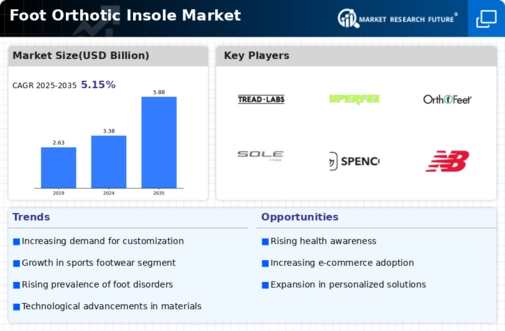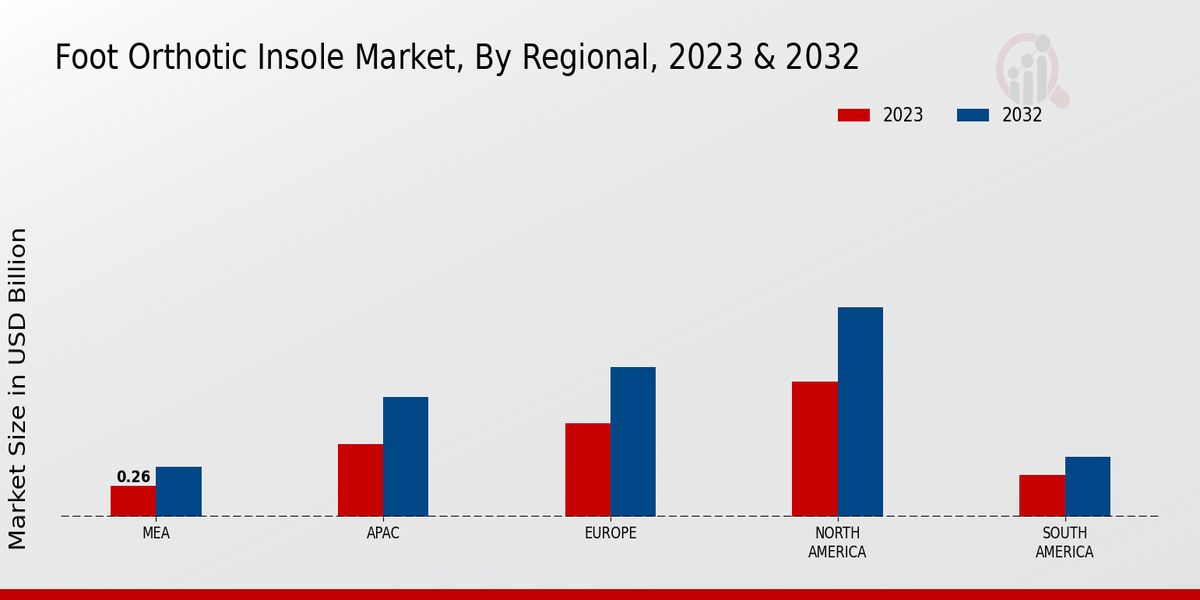Market Growth Projections
The Global Foot Orthotic Insole Market Industry is poised for substantial growth, with projections indicating a market value of 3.38 USD Billion in 2024 and an anticipated increase to 5.88 USD Billion by 2035. This growth trajectory suggests a compound annual growth rate (CAGR) of 5.16% from 2025 to 2035. Such figures reflect the increasing recognition of the importance of foot health and the expanding range of orthotic solutions available to consumers. The market's expansion is likely to be driven by various factors, including technological advancements, demographic changes, and heightened awareness of preventive healthcare.
Rising Prevalence of Foot Disorders
The Global Foot Orthotic Insole Market Industry is experiencing growth due to the increasing prevalence of foot disorders such as plantar fasciitis, flat feet, and diabetic foot ulcers. According to health statistics, millions of individuals globally suffer from these conditions, leading to a heightened demand for orthotic solutions. This trend is particularly evident in aging populations, where foot-related ailments are more common. The market is projected to reach 3.38 USD Billion in 2024, reflecting the urgent need for effective treatment options. As awareness of foot health continues to rise, the demand for customized orthotic insoles is likely to increase, further driving market expansion.
Growing Awareness of Preventive Healthcare
The Global Foot Orthotic Insole Market Industry is benefitting from a growing awareness of preventive healthcare among consumers. Individuals are increasingly recognizing the importance of foot health in overall well-being, leading to proactive measures such as the use of orthotic insoles. This shift in consumer behavior is driven by educational campaigns and healthcare professionals advocating for preventive solutions. As people seek to avoid potential foot problems, the demand for orthotic insoles is likely to rise. This trend is expected to support the market's growth, with projections indicating a market value of 5.88 USD Billion by 2035, highlighting the long-term potential of preventive foot care.
Increase in Sports and Physical Activities
The Global Foot Orthotic Insole Market Industry is experiencing a surge in demand due to the rising participation in sports and physical activities. As more individuals engage in running, hiking, and other athletic pursuits, the incidence of foot-related injuries is also increasing. Athletes and fitness enthusiasts are increasingly turning to orthotic insoles to enhance performance and prevent injuries. This trend is particularly pronounced among amateur athletes who seek to improve their comfort and support during physical activities. The market is projected to grow at a CAGR of 5.16% from 2025 to 2035, indicating a robust demand for specialized insoles designed for active lifestyles.
Technological Advancements in Insole Design
Innovations in materials and manufacturing processes are significantly influencing the Global Foot Orthotic Insole Market Industry. Advanced technologies such as 3D printing and computer-aided design enable the production of highly customized insoles tailored to individual foot shapes and conditions. These advancements not only enhance comfort and support but also improve the overall effectiveness of orthotic treatments. As a result, consumers are increasingly opting for technologically advanced insoles that promise better outcomes. The integration of smart technology, such as pressure sensors, is also emerging, providing real-time feedback on foot health. This trend is expected to contribute to the market's growth trajectory in the coming years.
Aging Population and Increased Healthcare Expenditure
The Global Foot Orthotic Insole Market Industry is significantly influenced by the aging population and the corresponding increase in healthcare expenditure. As individuals age, they often experience various foot-related issues, necessitating the use of orthotic insoles for comfort and mobility. Governments and healthcare systems are increasingly investing in foot care solutions to address the needs of older adults. This demographic shift is expected to drive demand for orthotic products, as older individuals seek to maintain their quality of life. The market's growth is further supported by rising healthcare budgets, which facilitate access to specialized foot care solutions.














